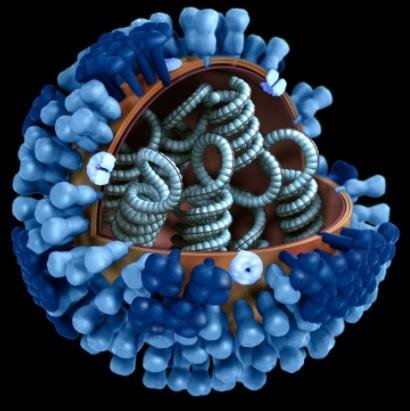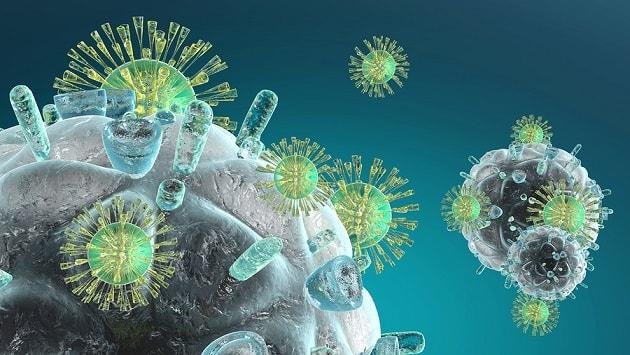Las enfermedades más comunes causadas por virus incluyen el ébola, la gripe, la fiebre amarilla, el virus de la inmunodeficiencia humana (VIH / SIDA), el virus del papiloma humano (VPH), la gastroenteritis viral, la varicela, y la hepatitis viral, entre otros.
A las enfermedades causadas por virus, se les conoce como enfermedades o infecciones virales. Estas son causadas por agentes infecciosos que viven y se propagan al interior de las unidades celulares vivas.
.jpg]
These infectious agents are known as viruses. A virus can be defined as a microscopic pathogen, much smaller than most bacteria (Mandal, 2013). They consist of a coating of protein and genetic material inside.
Viruses are the most numerous biological structures on the planet, being very dangerous for humans because they can cause infections and diseases of all kinds.
The diseases they cause range from a cold to diseases as serious as HIV / AIDS.
A disease does not always appear when a virus is acquired, because the immune system may be able to fight it. However, some viruses can attack certain cells, multiply within them and spread.

For the generality of viral diseases, treatments only improve symptoms while the immune system attacks the virus.
Antibiotics do not work for viral type infections. There are antiviral medicines to deal with some and vaccines can make infection more difficult.
Viruses can remain in the cell without damaging it, making it a carrier. The patient seems healthy, but the infection may arise after a period of latency (Medline Plus, 2017).
In the organism a form of immunity can be given that lasts a while, because the virus enters, the organism confronts it and remembers it producing specific antibodies against it avoiding acquiring it again.
major diseases caused by viruses
1 - Ebola
It is a disease caused by the namesake virus (Ebola). It is considered one of the most contagious viral and infectious diseases in the world. Its spread occurs both in animal species and in humans.
Its most important symptom is the hemorrhagic fever that it generates. This condition leads to muscle aches, physical exhaustion, severe headache. abdominal pain, high fevers and appearance of skin rashes (Meganotas, 2017).
Its transmission is given by having direct contact with any type of fluid derived from an individual carrying the virus. These fluids include leakage, sweat, vomiting or urine.
2 - Gastroenteritis
Gastroenteritis is known as the "stomach flu." It consists of severe inflammation of the digestive system, including stomach and intestines. You can receive the alternate name of rotavirus or Norwalk virus.
Its contagion occurs when an individual or group of individuals consume the same food or drink contaminated by the microorganisms that cause the virus.
The first symptoms of the presence of this disease appear almost immediately and are nausea, vomiting and diarrhea.
Gastroenteritis caused by the transmission of a virus is common in people of all ages. Also, it can be divided into several types that include rotavirus, norovirus, enteric adenovirus and astrovirus.
This disease can be treated by preventing dehydration, by increasing the consumption of beverages rich in salts and minerals.
3 - Dengue
Dengue disease is named after the virus that produces it (dengue). It is one of the most common viral diseases that exist in the world, infecting more than 100 million people annually.
Like yellow fever, it is transmitted through the bite of the Aedes Aegypti fly. It feeds on the blood of an infected person and subsequently passes the virus to a healthy person through its bite.
The Aedes Aegypti fly breeds in places where there are stagnant waters, laying their eggs on the walls or banks of these water wells. The virus can also be transmitted by consuming water contaminated with fly eggs.
Among the most common symptoms of dengue are lymph node growth, severe muscle pain, fever, joint pain and the occasional appearance of skin rashes.
Like other viral diseases, dengue can be prevented by applying a single dose vaccine in patients between 0 and 12 months of age.
4 - Yellow Fever
This disease is called the virus that causes it (the yellow fever virus). It is more common to find patients infected with this virus in continents such as Africa, South America and Central America (including the Caribbean islands).
Its spread is through the bite of a mosquito known as Aedes Aegypti, Aedes Sabethes or Aedes Haemagogus, which feeds on the blood of the person infected with the virus and then transmits it to other healthy people through its bite ( Liboreiro, 2015).
Symptoms such as nose and mouth bleeding, yellow skin pigmentation, dark vomiting, cardiac arrhythmia, dehydration and high fever may occur in people with this type of virus.
It is a disease that can be prevented through vaccination. This vaccination must take place between the ages of 9 and 60 and must be reapplied every 10 years.
5 - Flu
The flu is one of the most common viral diseases in humans. This occurs when the RNA virus lodges and reproduces in the body's cells.
It usually affects the airways, and is often confused with a cold during its first phase of development.
The most common symptoms that are evident in the presence of this disease are headache, fever, malaise, body weakness, dry cough, vomiting, diarrhea and sore throat.
It is important to note that the RNA virus is transmitted by air, through small particles of liquid that are released when you cough, talk or sneeze.
This disease can be prevented by the application of influenza vaccines. These vaccines usually protect patients from different types of flu, including swine (H1N1).
It is recommended to vaccinate only once to adults over 65 during the autumn season.
`
6 - Chickenpox
Chickenpox is an infectious disease that occurs when the body's cells acquire a virus known as varicella zoster.
It is a disease commonly acquired by individuals under 15 years of age. However, it can also be transmitted to children over 15 years and adults. This is because it is a virus that is easily transmitted from one person to another.
Patients with chickenpox virus are easily detected due to skin rashes.
These rashes generate a sensation of piquiña, and gradually transform into reddish-colored blisters filled with liquid. Each blister eventually becomes a scab that, when dropped, can leave definitive marks on the skin.
The places where rashes most commonly appear are the back, face, and chest. However, the virus tends to spread throughout the body, and blisters can be found in the rest of the bodySome symptoms of chickenpox include headache, physical exhaustion, loss of appetite and fever.
This type of disease is almost never serious and tends to last less than 10 days. It is common to treat it with ointments, lotions and skin creams. Some doctors recommend taking oatmeal baths and using products that reduce hives.
The most severe cases of chickenpox can occur in pregnant women, infants, adolescents, adults, and individuals with immune systems weakened by other diseases. In these cases it is recommended to take antiviral medication.
7 - HIV / AIDS
The Human Immunodeficiency Virus or HIV attacks the immune system, making people susceptible to acquiring life-threatening infections.
AIDS or Acquired Immunodeficiency Syndrome is the period of HIV infection, where there are low levels of defenses and there is the appearance of rare infections called opportunistic, which arise when the immune defenses of the person infected with HIV are scarce.
Normally, a healthy organism could fight them, but an infected organism is unable to defend itself.
This virus is transmitted through unprotected sex, by sharing syringes or any object that can hurt and has been in contact with infected blood.
It can also be transmitted by a mother to her baby, either during the period of breastfeeding or at the time of delivery.
It is prevented by having sex with protection, always using sterile material for piercings or tattoos and avoiding sharing syringes, if injected drugs are used (Infosida, 2017).
Nowadays, thanks to the antiretroviral treatment, an infected mother can have pregnancy and childbirth without the risk of the baby becoming infected.
8 - Viral hepatitis
Viral hepatitis is inflammation of the liver caused by any of the five hepatitis viruses (A, B, C, D and E) that can be transmitted in different ways.
Those of hepatitis A and E are transmitted by contaminated food and water, that of hepatitis B by blood and other unsafe body fluids and that of hepatitis C, only by infected blood
Hepatitis D virus infections only occur in people with hepatitis B. All these viruses cause acute hepatitis, which causes fatigue, fever, jaundice and decreased appetite. With proper treatment, a large percentage of people recover completely.
In addition, hepatitis B and C virus infections can become chronic and cause liver cancer or cirrhosis.
Hepatitis prevention measures are not enough, A and E can be avoided by consuming safe food and water. The A, B and E with vaccines. The C is of hematic transmission so it is necessary to take care that the material of injections and transfusions is sterile and safe.
9 - Human papilloma (HPV)
Human papillomavirus (HPV) is a group of more than 200 types of viruses related to each other. These viruses cause warts on different parts of the body and about 40 of them affect the genital area.
They spread by sexual contact with an infected person. Some of these viruses can lead to cancer.
There are two types of sexually transmitted HPV. Low-risk HPV that causes genital warts and high-risk warts can cause several types of cancer, such as cervix, anus, vagina or penis.
These infections are very common and every sexually active person can get it, especially if they have many sexual partners.
A large number of people overcome HPV infections in two or three years without developing cancer, other infections can persist for many years and others can cause cell changes that, if left untreated, can become cancerous.
Thanks to cytology, women can timely detect changes in the cervix that could become cancerous. The use of condoms and vaccines can prevent the risk of contracting and transmitting HPV
10 - Infectious mononucleosis
It is a viral disease known as kissing disease. It is caused by the Epstein-Barr virus (EBV), but it can also be caused by the cytomegalovirus that is transmitted orally and causes swollen lymph nodes with fever, general weakness, pharyngitis and headache.
It mainly attacks teenagers and young people. It is almost always a benign process in which the body's defense response is basic.
It is spread by coming into contact with kitchen utensils, coughing, sneezing, or kissing of an infected person, or by a blood transfusion.
There is no concrete and effective treatment against this disease, therefore only medicines that relieve the discomforts it causes are used
Source
Plagiarism is the copying & pasting of others work without giving credit to the original author or artist. Plagiarized posts are considered spam.
Spam is discouraged by the community, and may result in action from the cheetah bot.
More information and tips on sharing content.
If you believe this comment is in error, please contact us in #disputes on Discord
Hi! I am a robot. I just upvoted you! I found similar content that readers might be interested in:
https://www.lifepersona.com/10-diseases-caused-by-the-most-common-viruses